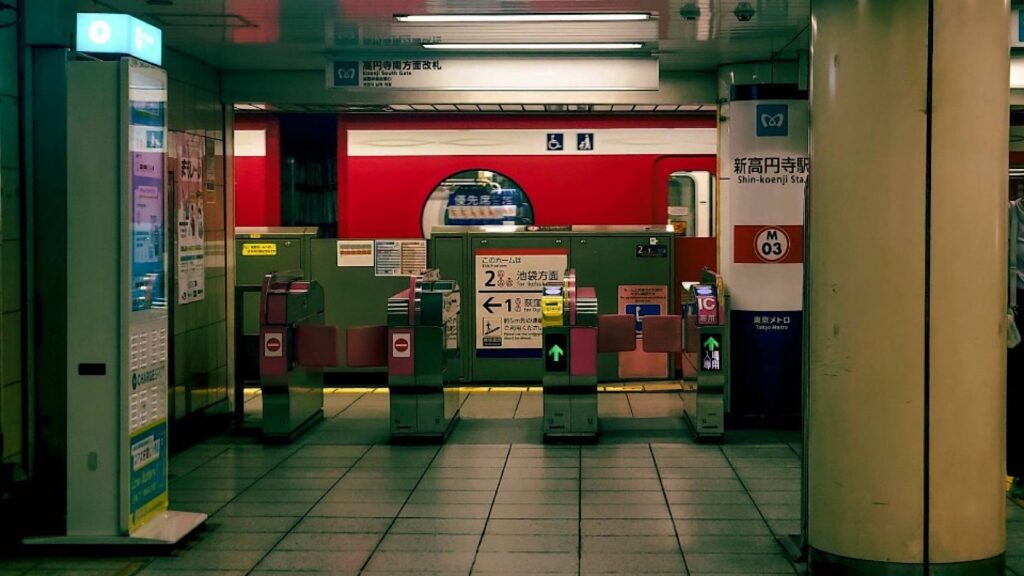5/7/2025 Sayurann

There’s a subway line called the Marunouchi Line—the only one that runs through Suginami Ward. It connects Ogikubo Station in Suginami to Ikebukuro Station in Toshima Ward. Along the way, it stops at several major terminal stations like Shibuya and Tokyo, linking up with many other train lines.
At first glance, it seems like a great train line. But if you board at Ogikubo, the journey to Ikebukuro takes about 50 minutes, simply because the train winds its way through so many stations. If there were a more direct route to Ikebukuro, I imagine it wouldn’t take nearly as long. Instead, the Marunouchi Line takes a curved, almost circular path—so much so that I doubt anyone living in Suginami uses it to go to Ikebukuro. Access from Suginami to Ikebukuro still, even today, requires at least one transfer. Compared to places like Shinjuku, Shibuya, or Tokyo Station—where you can get to directly—Ikebukuro just feels inconveniently out of reach. For me, Ikebukuro has become a place I only go to when there’s a shop I can’t find anywhere else, or when I’m meeting someone who lives nearby. Am I the only one who feels this way?
Another thing that’s always puzzled me: the Marunouchi Line stops in four different spots around Shinjuku Station. I’ve never really looked into the reasoning behind this, so I’m not sure what the advantage is, but sometimes when I’m heading back toward Shinjuku and find a random ticket gate in an unexpected place, it turns out to be a Marunouchi Line entrance. It’s surprisingly convenient, yet I can’t help but think, “Why did they build a station here of all places?” It’s both helpful and bewildering at the same time.
Also, on the Suginami side, the station names can be a bit confusing if you’re used to JR lines. Some of the stations have names that just add a character like “Shin-” or “Higashi-” to the beginning of familiar JR station names, so it’s hard to tell if you’re actually near the JR station or not.
That said, the neighborhoods around the stations on the Suginami end of the line are full of supermarkets, general stores, and other amenities that make daily life easy. They’re great places to live. I have friends who live in that area and they say the balance is just right—not too noisy, not too quiet.
On the Ikebukuro end, there are unique advantages too. For example, it stops at both Tokyo and Otemachi Stations, which are close enough to walk between—kind of a rare route. It also stops at Korakuen Station, right near Tokyo Dome, making it ideal for people heading to baseball games or concerts.
So while the Marunouchi Line remains a bit of a mystery to me, even after many years of living in Tokyo, I can’t deny how convenient it is for getting around and making transfers between lines. It’s one of the most heavily used train lines in Japan for a reason. I use it all the time for work these days, and I know how essential it is to my daily life. Still, I can’t help but quietly wish that the detour from Suginami to Ikebukuro could be just a little shorter. I’m sure I’m not the only one in Suginami who hopes it’ll one day be easier to get to Ikebukuro.
[Reference URL] https://hbol.jp/pc/212656/
(原文)
杉並区を通る唯一の地下鉄である、丸の内線という電車がある。 杉並区の荻窪駅から豊島区の池袋駅を繋ぐ電車です。途中、渋谷駅、東京駅といった多くのター ミナル駅に停車し、多くの乗り換え路線と接続しています。 ここまで書くと素晴らしい電車ではあるのだが、荻窪駅から乗車した場合、上記の通り、多数の 駅を経由するため、池袋駅まで50分ほどかかる。より直線的に池袋駅に向かってくれるルートで あれば、それほど時間はかからずに到着すると思うのだが、まるで円を描くかのような迂回を経 て池袋駅まで向かうルートになっている。そのため、杉並区に在住の方で、丸の内線を利用して 池袋まで向かう人はいないと思う。 杉並区内から池袋へのアクセスは、昔と変わらず、必ず電車の乗り換えが必要であり、乗り換えな しで行ける新宿駅や渋谷駅、東京駅と比較すると行き辛く感じてしまう場所である。池袋にしか ないお店、池袋寄りに住んでいる知り合いに会う時のみ行く場所に池袋がなってしまったのは私 だけだろうか…。
私にとって気になる点であるのだが、新宿駅周辺には4箇所停車する。一度も調べたことがないの でメリットはよくわからないのだが、新宿駅から少し遠ざかった場所から新宿駅へ戻る途中で、 こんなとこに改札があるじゃん!という時に、丸の内線の改札だったりする。これがまた絶妙な ので、便利といえば便利なのですが、素直に喜ぶというよりは、すごいところに駅を作ったなと いう驚きと戸惑いを感じます。
また、杉並区側の駅名は、JRに乗ることに慣れている人にとっては、JRの駅名の先頭に「新」や 「東」という1文字がついたりするので、果たしてJRから乗り換える場合、近いのか遠いのか判 断がつきづらい。 ただし、杉並区側の駅の周りにはスーパーや雑貨屋など生活がしやすい環境が整っており、住む のにオススメな街である。私の知り合いでも住んでいる人もおり、賑やか過ぎず、落ち着き過ぎて いないという絶妙なバランスが良いと聞いた。
逆に、池袋側の駅では、歩いてもすぐ辿り着くこともできる東京駅と大手町駅の両方に停車する というレアな経路、プロ野球やコンサート観戦で訪れる方々が多い東京ドーム近くの後楽園駅に 停車するといった素晴らしい側面がある。
という感じで、東京暮らしが長い私でも謎の多い丸の内線ですが、乗車率は日本屈指であり、数 駅を乗り継ぐのに便利な電車です。最近、仕事関係で場所移動が多く、日々利用させて頂いてい るので、生活になくては困る電車であるのは重々承知しているが、杉並区から池袋への迂回距離 をもう少し短くしてくれないかと心の底で願っている。杉並区民を池袋に行きやすくして欲しい! そう思っている人は私だけではきっとないはず。
〈参考URL〉 https://hbol.jp/pc/212656/
